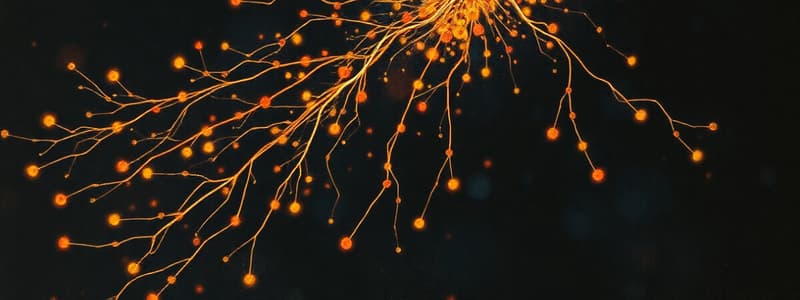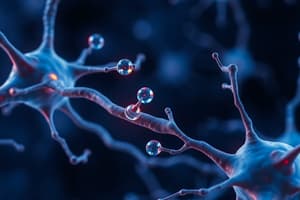Podcast
Questions and Answers
What is the critical ion required for vesicle fusion during neurotransmitter release?
What is the critical ion required for vesicle fusion during neurotransmitter release?
- Na+
- Ca2+ (correct)
- K+
- Cl-
Which type of synapse allows for fast, bidirectional communication?
Which type of synapse allows for fast, bidirectional communication?
- Axon-axonic synapse
- Chemical synapse
- Electrical synapse (correct)
- Neuromuscular junction
Which of the following proteins acts as a calcium sensor during vesicle fusion?
Which of the following proteins acts as a calcium sensor during vesicle fusion?
- Calcium channel
- Synapsin
- Synaptotagmin (correct)
- SNARE complex
What is the rate-limiting enzyme involved in the synthesis of acetylcholine?
What is the rate-limiting enzyme involved in the synthesis of acetylcholine?
Which of the following is NOT a characteristic of an action potential?
Which of the following is NOT a characteristic of an action potential?
Which type of glial cell is responsible for the formation of the blood-brain barrier?
Which type of glial cell is responsible for the formation of the blood-brain barrier?
What is the primary function of the axon hillock?
What is the primary function of the axon hillock?
Which type of axoplasmic transport moves materials from the axon terminal back to the soma?
Which type of axoplasmic transport moves materials from the axon terminal back to the soma?
Which of the following statements about the neuronal cytoskeleton is TRUE?
Which of the following statements about the neuronal cytoskeleton is TRUE?
What is the Nernst equation used to calculate?
What is the Nernst equation used to calculate?
Which of the following is NOT a function of glial cells?
Which of the following is NOT a function of glial cells?
What is the function of dendrites in a neuron?
What is the function of dendrites in a neuron?
What is the term for branches of an axon that synapse on the neuron itself?
What is the term for branches of an axon that synapse on the neuron itself?
What type of glial cell is responsible for the formation of myelin in the central nervous system?
What type of glial cell is responsible for the formation of myelin in the central nervous system?
The resting membrane potential of a neuron is primarily determined by the permeability of the cell membrane to potassium ions.
The resting membrane potential of a neuron is primarily determined by the permeability of the cell membrane to potassium ions.
What are the two primary types of axoplasmic transport and what direction do they move materials?
What are the two primary types of axoplasmic transport and what direction do they move materials?
The ______ is the junction between two neurons where communication occurs.
The ______ is the junction between two neurons where communication occurs.
Match the following structures with their primary function:
Match the following structures with their primary function:
Which of the following is NOT a key feature of action potentials?
Which of the following is NOT a key feature of action potentials?
Electrical synapses are faster than chemical synapses.
Electrical synapses are faster than chemical synapses.
What are the two primary mechanisms that contribute to the speed of action potential conduction along an axon?
What are the two primary mechanisms that contribute to the speed of action potential conduction along an axon?
The ______ complex is a key component of the molecular machinery responsible for vesicle fusion during neurotransmitter release.
The ______ complex is a key component of the molecular machinery responsible for vesicle fusion during neurotransmitter release.
Match the following neurotransmitter types with their corresponding rate-limiting enzyme:
Match the following neurotransmitter types with their corresponding rate-limiting enzyme:
Flashcards
Neuron Doctrine
Neuron Doctrine
Neurons are the basic unit of the nervous system for signaling.
Types of Cells in Nervous System
Types of Cells in Nervous System
Neurons conduct impulses; glial cells support neurons.
Axoplasmic Transport
Axoplasmic Transport
Movement of materials within axons; anterograde and retrograde types.
Components of Cytoskeleton
Components of Cytoskeleton
Signup and view all the flashcards
Functions of Astrocytes
Functions of Astrocytes
Signup and view all the flashcards
Resting Membrane Potential
Resting Membrane Potential
Signup and view all the flashcards
Nernst Equation
Nernst Equation
Signup and view all the flashcards
Neural Circuits
Neural Circuits
Signup and view all the flashcards
Action Potential Phases
Action Potential Phases
Signup and view all the flashcards
Synaptic Transmission Steps
Synaptic Transmission Steps
Signup and view all the flashcards
Types of Synapses
Types of Synapses
Signup and view all the flashcards
Ionotropic vs. Metabotropic Receptors
Ionotropic vs. Metabotropic Receptors
Signup and view all the flashcards
Excitatory vs. Inhibitory Neurotransmitters
Excitatory vs. Inhibitory Neurotransmitters
Signup and view all the flashcards
Action Potential Graph
Action Potential Graph
Signup and view all the flashcards
Action Potential Features
Action Potential Features
Signup and view all the flashcards
Speed Increase Mechanisms
Speed Increase Mechanisms
Signup and view all the flashcards
Neurotransmitter Release Steps
Neurotransmitter Release Steps
Signup and view all the flashcards
Post-Synaptic Receptors
Post-Synaptic Receptors
Signup and view all the flashcards
Neuron Components
Neuron Components
Signup and view all the flashcards
Neurites
Neurites
Signup and view all the flashcards
Axon Collaterals
Axon Collaterals
Signup and view all the flashcards
Recurrent Collaterals
Recurrent Collaterals
Signup and view all the flashcards
Glial Cells Functions
Glial Cells Functions
Signup and view all the flashcards
Ion Transport Types
Ion Transport Types
Signup and view all the flashcards
Dendritic Arbor Regulation
Dendritic Arbor Regulation
Signup and view all the flashcards
CNS vs PNS
CNS vs PNS
Signup and view all the flashcards
Study Notes
Neuron Structure and Function
- Neurons are the basic structural and functional units of the nervous system, responsible for receiving, processing, and transmitting electrical signals.
- Glial cells support neurons and include astrocytes, oligodendrocytes, Schwann cells, microglia, and ependymal cells.
- Neuron labeling includes identifying the soma, dendrites, axon, axon hillock, and synapse.
- Neurites are processes extending from the soma, including dendrites and axons. Axon collaterals are branches of an axon, while recurrent collaterals synapse on the neuron itself.
- Cytoskeleton components, including microtubules, neurofilaments, and actin microfilaments, provide structure, transport, stability, and motility to the neuron.
- Axoplasmic transport includes anterograde (soma to axon terminal) and retrograde (terminal to soma) transport.
- Protein synthesis occurs primarily in the soma with limited synthesis in axons and dendrites.
- Neuron types include sensory, motor, and interneurons.
- Dendritic arbor regulation modifies synaptic input strength.
Glial Cells and Nervous System Organization
- Glial cell types include astrocytes, oligodendrocytes, microglia, ependymal cells in the CNS, and Schwann cells, satellite cells in the PNS.
- Glial cells provide support, maintain the blood-brain barrier, myelinate axons, participate in immune responses, and produce cerebrospinal fluid.
Nervous System Organization
- Nervous system organization separates the CNS (brain and spinal cord) from the PNS (nerves and ganglia).
Membrane Properties and Electrical Signaling
- Neuron membrane structure is composed of a phospholipid bilayer and ion channels.
- Ion transport includes passive ion channels and active pumps like the Na+/K+ ATPase.
- Resting membrane potential is influenced by ion gradients and selective membrane permeability.
- The Nernst and Goldman equations define equilibrium and membrane potential, respectively.
- Action potentials are characterized by an all-or-none response, refractory periods, and phases including resting membrane potential, threshold, depolarization, repolarization, and hyperpolarization.
- Action potential speed increases through myelination and larger axon diameter.
- Voltage-gated Na+ and K+ channels control action potential generation and propagation.
Synaptic Transmission and Neurotransmitters
- Synapses are classified as electrical and chemical.
- Chemical synapses involve neurotransmitter release.
- Neurotransmitter release steps include action potential triggering Ca2+ influx, facilitating vesicle fusion, and neurotransmitter release.
- Synaptic vesicle fusion relies on proteins like synaptotagmin and SNARE complexes.
- Postsynaptic receptors are ionotropic (fast, ligand-gated) or metabotropic (slow, G-protein coupled).
- Neurotransmitters are classified by their structure, function, and receptor interaction. Criteria for neurotransmitters include being synthesized in neurons, being released upon stimulation, and producing a response to stimulation.
- Specific neurotransmitter synthesis steps and rate-limiting steps are also described (e.g., for acetylcholine, catecholamines, serotonin, and amino acid neurotransmitters).
- Different neurotransmitters are categorized as excitatory (e.g., glutamate, acetylcholine) or inhibitory (e.g., GABA, glycine).
Studying That Suits You
Use AI to generate personalized quizzes and flashcards to suit your learning preferences.



